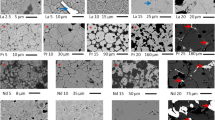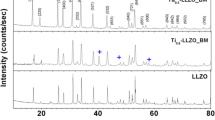Abstract
Six \( {\text{La}}_{{0.4}} {\text{Ca}}_{{0.5}} {\text{Ti}}_{{0.5}} {\text{Cr}}_{{0.4}} {\text{M}}_{{0.1}} {\text{O}}_{{3 - \delta }} \) (M = Cr, Mn, Fe, Co, Ni, Cu) and two \( {\text{La}}_{{0.4}} {\text{Ca}}_{{0.4}} {\text{Ti}}_{{0.4}} {\text{Cr}}_{{0.4}} {\text{M}}_{{0.2}} {\text{O}}_{{3 - \delta }} \) (M = Ni, Cu) single-phase compositions were prepared by conventional solid-state reactions. Oxygen nonstoichiometry, electrical conductivity, phase transformations under reduction-reoxidation at high temperatures and catalytic activity for hydrocarbons oxidation of these compositions were investigated in a wide temperature and oxygen partial pressure range. The Cu-, Ni-, Co-, and Fe-containing compositions are decomposed in reducing Ar/H2O/H2 atmosphere with pH2O / pH2 = 0.3 at 1,000 °C, while the Cr- and Mn-containing ceramics remain stable at the same conditions. The metallic particles of the added 3d elements formed after decomposition were registered by X-ray diffraction method in case of Cu- and Ni-containing compositions. These formed composites can be completely reoxidized with formation of initial compositions by treatment in air at 1,000 °C. The electrical conductivity of the ceramics investigated in air and Ar/H2O/H2 gas flow increases with rising M content. The highest catalytic activity for oxidation of CH4 and C3H6, which was comparable with the activity of the \( {\text{La}}_{{0.4}} {\text{Ca}}_{{0.5}} {\text{Ti}}_{{0.5}} {\text{Cr}}_{{0.5}} {\text{O}}_{{3 - \delta }} + 5\% {\text{NiO}} \) composite, shows the Cu-containing powders.















Similar content being viewed by others
References
Tanasescu S, Berger D, Neiner D, Totir ND (2003) Solid State Ion 157:365
Flandermeyer BK, Nasrallah MN, Agarwal AK, Anderson HU (1984) J Am Ceram Soc 67:195
Karim DP, Aldred AD (1979) Phys Rev B 20:2255
Yasuda I, Hishinuma M (1995) Solid State Ion 80:141
Peck D-H, Miller M, Hilpert K (2001) Solid State Ion 143:401
van Hassel BA, Kawada T, Sakai N, Yokokawa H, Dokiya M (1993) Solid State Ion 66:41
Marina OA, Canfield NL, Stevenson JW (2002) Solid State Ion 149:21
Mitchell H, Chakhmouradian AR (1999) J Solid State Chem 144:81
Kennedy BJ, Howard CJ, Thorogood GJ, Mestre MAT, Hester JR (2000) J Solid State Chem 155:455
Li G, Kuang X, Tian Sh, Liao F, Jing X, Uesu Y, Kohn K (2002) J Solid State Chem 165:381
Bansal KP, Kumari S, Das BK, Jain GC (1983) J Mater Sci 18:2095–2100
Palguev SF, Gilderman VK, Zemtzov VI (1990) High temperature oxide electronic conductors for the electrochemical devices. Nauka, Moscow, p 197
Vashook V, Vasylechko L, Zosel J, Gruner W, Ullmann H, Guth U (2004) J Solid State Chem 177:3784
Vashook V, Vasylechko L, Ullmann H, Guth U (2006) J Alloys Compd 354:13
Sfeir J, Buffat Ph, Möckli P, Xanthopoulos N, Vasquez R, Mathieu H, van Herle J, Thampi K (2001) J Catal 202:229–244
Sfeir J, van Herle J, McEvoy AJ (1998) In: Stevens P (ed) Proceedings of the 3rd European solid oxide fuel cell forum. Nantes, France, p 267
Teske K, Ullmann H, Trofimenko N (1997) J Therm Anal 49:1211
Bode M, Teske K, Ullmann H (1994) GIT Fachzeitschrift Lab 38:495
Vashook V, Al Daroukh M, Ullmann H (2000) Ionics 7:59
Vashook V, Vasylechko L, Trofimenko N, Kuznecov M, Otchik P, Zosel J, Guth U (2006) J Alloys Compd 419:271–280
Vashook V, Vasylechko L, Zosel J, Ullmann H, Guth U (2004) Crystal structure and electrical conductivity of lanthanum-calcium chromites–titanates \( {\text{La}}_{{1 - x}} {\text{Ca}}_{x} {\text{Cr}}_{{1 - y}} {\text{Ti}}_{y} {\text{O}}_{{3 - \delta }} {\left( {x = 0 \div 1,\;y = 0 \div 1} \right)} \). J Solid State Chem 177:3784–3794
Borg RJ, Dienes GJ (1992) The physical chemistry of solids. Academic, San Diego, p 584
Tretyakov Yu D, Komarov VF, Kutsenok IB, Prosvirnina NA (1972) J Solid State Chem 5:157
Vashook V, Zosel J, Preis W, Sitte W, Guth U (2004) Solid State Ion 175:441–444
Author information
Authors and Affiliations
Corresponding author
Additional information
Dedicated to Prof. Dr. Werner Weppner
Rights and permissions
About this article
Cite this article
Vashook, V., Müller, R., Zosel, J. et al. A-site deficient lanthanum-calcium chromite-titanates doped with 3d transition metals: synthesis, oxygen nonstoichiometry, electrical conductivity, and catalytic activity. Ionics 13, 141–149 (2007). https://doi.org/10.1007/s11581-007-0083-1
Received:
Accepted:
Published:
Issue Date:
DOI: https://doi.org/10.1007/s11581-007-0083-1




